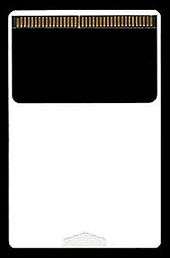HuCard

The HuCard (Japanese: ヒューカード Hepburn: HyūKādo) is a ROM cartridge in the form of a card, designed by Hudson Soft for NEC's PC-Engine and PC Engine SuperGrafx video game consoles, which premiered in 1987 and 1989, respectively.
The HuCard is an evolution from an earlier Hudson Soft technology, the Bee Card, which it developed in the early 1980s as a distribution medium for MSX computer software. The Bee Card is an EEPROM device that is slightly thinner than the HuCard. It has 32 connectors whereas the HuCard has 38. Most video game cartridges have a large plastic housing to protect the PCB while providing enough space inside for radiant heat and, less often, a button cell. The PCB in a HuCard or Bee Card is protected by a rigid, glossy polymer that conducts heat; since the PC Engine and TurboGrafx-16 leave one side of the card partially exposed while inserted in the console, heat disperses with less obstruction.
Hudson Soft, NEC, and other vendors published seven HuCard titles specifically for the PC Engine SuperGrafx. Hudson Soft called this enhanced medium the Super HuCard.
In the United States, where the PC-Engine was marketed as the TurboGrafx-16, the HuCard is alternately called the TurboChip. Video game developers published new titles on HuCard/TurboChip until 1993.